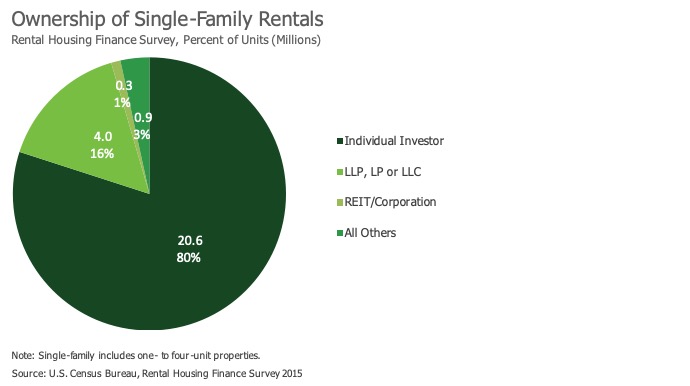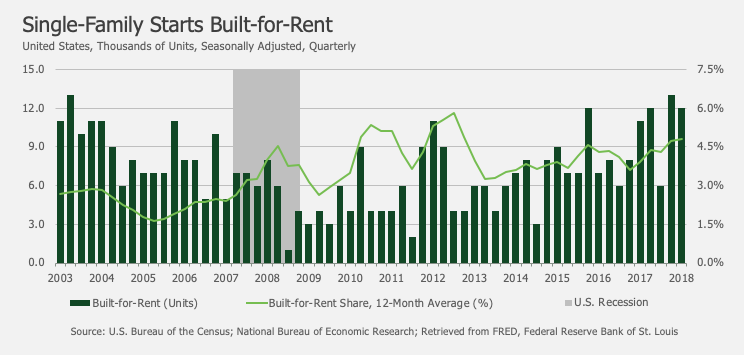Single-Family Rental Portfolio Financing Trends

As commercial real estate investors move further out on the yield spectrum, they are increasingly considering the single-family rental (SFR) asset class. Large portfolio transactions have made headlines in recent years, yet individual investors still own 80% of the SFR marketplace. Demand for debt financing in the sector is high, and an enormous amount of capital is still waiting to be deployed.

The Federal Housing Finance Agency recently concluded its SFR pilot program for Fannie Mae and Freddie Mac. Despite its short run, the pilot revealed a strong demand for financing of this product and brought forward new investors into the space. It also resulted in increased lending competition and accelerated lending standardization.
Economic Factors
Forward-looking demographics remain favorable for single-family rentals. Homeownership has increased recently, rising to 64.6% at the end of 2018, as compared with the low of 63.7% during 2016. However, the current rate is below the historical high of 69.2% through 2004, and homeownership is expected to remain inhibited by limited new supply, slow wage growth, and rising mortgage rates.
Entry-level housing has become unattainable for many. As a result, apartment renters who prefer more space are choosing to rent instead of buy single-family homes. A generation of would-be homebuyers that witnessed the Great Recession no longer view homeownership as an investment and many prefer the flexibility of renting.

It’s evident the economy has neared the mature end of this cycle and some economists have predicted a recession in 2020, citing trade policy and rising interest rates. However, expansions don’t die of old age and there are no major signals of a recession at this time.
Rising interest rates haven’t begun to affect demand for SFR portfolio financing. As rates increase, single-family investors are protecting themselves by refinancing adjustable rate mortgages into four- to five-year fixed rate loans; considering adding value-add properties to their portfolios; and ensuring quality tenants to extend occupancy duration and maintain stabilized rental income.
Flexible Financing for SFR Portfolios
The SFR market is rapidly evolving and investors are changing strategies, calling for new and adaptive financial products. Borrowers are looking for flexible financing, not only to deal with challenges, but also to take advantage of opportunities. Depending on their strategy, investors are looking for both short- and long-term financing to be available, as well as flexible pre-pay options.
Long-term borrowers want the flexibility to add or remove properties from their portfolio. This allows the borrower to keep the portfolio optimized over the course of the loan, by removing underperforming properties and adding better assets. Substitutions can affect the rating of the overall portfolio, so additions and removals should be only made after consideration of how they change the markets represented, the operating income and the average school ratings of the homes in the portfolio.
In this environment, lenders need to focus on more than just terms and rates. Lenders need to become a partner for the investor by focusing on the borrower relationship and better customer service during loan origination and loan servicing lifetime.
Fix-and-Flip Strategy
While most borrowers of SFR debt tend to be long-term hold income investors, borrowers of short-term debt typically have two main strategies: build-to-rent and fix-and-flip.
Fix-and-flip projects, in which the investor buys and rehabs an existing property, then rents it out at a higher rental rate, tend to necessitate shorter-term financing. However, at this point in the cycle, fix-and-flip portfolios have become harder to find. As a result, these investors are becoming fix-and-hold investors by taking on longer-term debt. Fix-and-flip investors will be able to find new opportunities when the rates of foreclosure increase as the cycle turns.
Because fix-and-flip investments have been a harder find, the build-to-rent strategy has gained in popularity. These investors generally start off with short-term financing for construction, then move into longer-term financing when the portfolio has stabilized occupancy. Build-to-rents can be done in one-off lots, within other master-planned communities, or even as their own self-contained rental communities.
According to the U.S. Census Bureau and the National Association of Home Builders, the market share of built-for-rent single-family homes was 4.9% at the end of 2018, up from the historical average of 2.7% (1992-2012). This includes homes built and held for rental purposes and excludes homes built and sold to another party for rental purposes.

Build-to-Rent Strategy
Built-to-rent SFRs are attractive because they have lower construction costs than apartment buildings. This is mostly because they don’t have common area space like hallways and long-term maintenance costs can be optimized during construction by using more durable materials. They also can have lower costs than single-family, owner-occupied new construction by eliminating upgrade options and broker fees. Additionally, the one-year builder warranty eliminates all maintenance costs in the first year of occupancy.
Since these properties are newly built, they also tend to attract better tenants who stay in the property longer. The typical duration of occupancy for a new SFR is three to six years, while a typical apartment occupancy is 18 months. Given the higher rents in new properties, tenants are usually of higher quality and tend to take better care of a new property than they would an older unit.
Another significant piece of the build-to-rent model that’s gaining in popularity is building to sell. Portfolio investors may initially build the properties with a plan to rent them out when completed, but they also have the option of selling the properties to individual investors who are looking for a cash-flowing asset.
SFRs continue to evolve as a legitimate commercial real estate asset class as new investors and lenders enter the fray. Although today’s economic uncertainties weigh heavily on nearly all investment types, favorable demographics are expected to support the SFR segment in the longer-run. Regardless of what strategy investors choose to build their SFR portfolio, maintaining financial flexibility should be a primary focus.
Find the right financing solution to meet your investment needs by visiting our SFR financing page. For more on the SFR market, view our webinar.

